Hybrid Process Chain for the Integration of Direct Ink Writing and Polymer Injection Molding
Abstract
1. Introduction
2. Process Chain Development
3. Materials and Methods
3.1. Mold Surface Preparation
3.2. Direct-Write Printing
3.3. Injection Molding Setup
3.4. Imaging and Topography Characterization
3.5. Surface Energy and Polymer Melt Contact Angle
3.6. Mechanical Properties
3.7. Peeling Test
4. Results and Discussion
4.1. Influence of Surface Roughness
4.2. Surface Energy
4.3. Mechanical Integrity and Interface Strength
5. Conclusions
- Topographical analysis of the different surfaces to verify the proposed process when compared to printing directly onto molded parts as a post-process. Specifically, the surface roughness of parts with integrated traces was reported to be low compared to that of post-processed, printed structures. The improved surface finish is explained by the intrinsic rotation of the structures during the “transfer” process.
- The high surface roughness of the printed structure before molding was exploited to create favorable interlocking at the ink/polymer interface, increasing adhesion. The trace transfer process from the mold/ink interface to the ink/polymer interface is enabled by exploiting the similar surface energy between the materials. Specifically, the results demonstrated that the surface energy affinity at the ink/polymer interface must be stronger than that of the ink/mold interface to promote transfer, indicating the need for a pre-treatment coating.
- It was expected that the composite molded parts would retain the mechanical stability, of bulk ABS parts. Our statistical analysis verified this effect, where volumetric integration of the printed traces into the plastic does not affect their structural properties. Moreover, peeling tests and micrographs of cross-sections demonstrate sufficient adhesion strength between the polymer and the ink.
- This work presents a first-in-class study on the feasibility, and methods required to integrate, additive direct-write tools with injection molding. The result is a hybrid technique enabling the fabrication of custom, design-on-demand plastic parts with integrated conductive structures. Future work will focus on the integration of additional additive techniques and the integration of more complex structures and molding techniques.
Author Contributions
Funding
Acknowledgments
Conflicts of Interest
References
- Shemelya, C.; Cedillos, F.; Aguilera, E.; Maestas, E.; Ramos, J.; Espalin, D.; Muse, D.; Wicker, R.; MacDonald, E. 3D printed capacitive sensors. In Proceedings of the 2013 IEEE Sensors, Baltimore, MD, USA, 3–6 November 2013; pp. 1–4. [Google Scholar]
- Zadeh, E.; Sawan, M. High accuracy differential capacitive circuit for bioparticles sensing applications. In Proceedings of the 48th Midwest Symposium on Circuits and Systems, Covington, KY, USA, 7–10 August 2005; pp. 1362–1365. [Google Scholar] [CrossRef]
- Shemelya, C.; Zemba, M.; Liang, M.; Espalin, D.; Kief, C.; Xin, H.; Wicker, R.; MacDonald, E. 3D printing multi-functionality: Embedded RF antennas and components. In Proceedings of the 2015 9th European Conference on Antennas and Propagation (EuCAP), Lisbon, Portugal, 13–17 April 2015; pp. 1–5. [Google Scholar]
- Haghzadeh, M.; Armiento, C.; Akyurtlu, A. All-Printed Flexible Microwave Varactors and Phase Shifters Based on a Tunable BST/Polymer. IEEE Trans. Microw. Theory Tech. 2017, 65, 2030–2042. [Google Scholar] [CrossRef]
- Ghafar-Zadeh, E.; Sawan, M.; Therriault, D.; Rajagopalan, S.; Chodavarapu, V.P. A direct-write microfluidic fabrication process for CMOS-based Lab-on-Chip applications. Microelectron. Eng. 2009, 86, 2104–2109. [Google Scholar] [CrossRef]
- Khan, Y.; Thielens, A.; Muin, S.; Ting, J.; Baumbauer, C.; Arias, A.C. A New Frontier of Printed Electronics: Flexible Hybrid Electronics. Adv. Mater. 2020, 32, e1905279. [Google Scholar] [CrossRef] [PubMed]
- Feng, J.Q.; Loveland, A.; Renn, M.J. Aerosol Jet Direct Writing Polymer-Thick-Film Resistors for Printed Electronics. Preprints 2020, 2020020040. Available online: https://www.preprints.org/manuscript/202002.0040/v1 (accessed on 4 February 2020).
- Huang, Q.; Zhu, Y. Printed Electronics: Printing Conductive Nanomaterials for Flexible and Stretchable Electronics: A Review of Materials, Processes, and Applications (Adv. Mater. Technol. 5/2019). Adv. Mater. Technol. 2019, 4, 1970029. [Google Scholar] [CrossRef]
- Kwon, J.; Takeda, Y.; Shiwaku, R.; Tokito, S.; Cho, K.; Jung, S. Three-dimensional monolithic integration in flexible printed organic transistors. Nat. Commun. 2019, 10, 54. [Google Scholar] [CrossRef]
- Zhang, Y.-Z.; Wang, Y.; Cheng, T.; Yao, L.-Q.; Li, X.; Lai, W.-Y.; Huang, W. Printed supercapacitors: Materials, printing and applications. Chem. Soc. Rev. 2019, 48, 3229–3264. [Google Scholar] [CrossRef]
- Macdonald, E.; Salas, R.; Espalin, D.; Pérez, M.; Aguilera, E.; Muse, D.; Wicker, R. 3D Printing for the Rapid Prototyping of Structural Electronics. IEEE Access 2014, 2, 234–242. [Google Scholar] [CrossRef]
- Seifert, T.; Sowade, E.; Roscher, F.; Wiemer, M.; Gessner, T.; Baumann, R.R. Additive Manufacturing Technologies Compared: Morphology of Deposits of Silver Ink Using Inkjet and Aerosol Jet Printing. Ind. Eng. Chem. Res. 2015, 54, 769–779. [Google Scholar] [CrossRef]
- Haghzadeh, M.; Akyurtlu, A. All-printed, flexible, reconfigurable frequency selective surfaces. J. Appl. Phys. 2016, 120, 184901. [Google Scholar] [CrossRef]
- Dardona, S.; Shen, A.; Tokgoz, C. Direct Write Fabrication of a Wear Sensor. IEEE Sens. J. 2018, 18, 3461–3466. [Google Scholar] [CrossRef]
- Wang, J.; Pamidi, P.V.A.; Park, D.S. Screen-Printable Sol-Gel Enzyme-Containing Carbon Inks. Anal. Chem. 1996, 68, 2705–2708. [Google Scholar] [CrossRef] [PubMed]
- Kosmala, A.; Wright, R.; Zhang, Q.; Kirby, P. Synthesis of silver nano particles and fabrication of aqueous Ag inks for inkjet printing. Mater. Chem. Phys. 2011, 129, 1075–1080. [Google Scholar] [CrossRef]
- Kim, S.J.; Lee, J.; Choi, Y.-H.; Yeon, D.-H.; Byun, Y. Effect of copper concentration in printable copper inks on film fabrication. Thin Solid Films 2012, 520, 2731–2734. [Google Scholar] [CrossRef]
- Bakhishev, T.; Subramanian, V. Investigation of Gold Nanoparticle Inks for Low-Temperature Lead-Free Packaging Technology. J. Electron. Mater. 2009, 38, 2720–2725. [Google Scholar] [CrossRef]
- Gangwar, A.K.; Nagpal, K.; Kumar, P.; Singh, N.; Gupta, B.K. New insight into printable europium-doped yttrium borate luminescent pigment for security ink applications. J. Appl. Phys. 2019, 125, 074903. [Google Scholar] [CrossRef]
- Tao, H.; Marelli, B.; Yang, M.; An, B.; Onses, M.S.; Rogers, J.A.; Kaplan, D.L.; Omenetto, F.G. Inkjet Printing of Regenerated Silk Fibroin: From Printable Forms to Printable Functions. Adv. Mater. 2015, 27, 4273–4279. [Google Scholar] [CrossRef]
- Sun, K.; Wei, T.-S.; Ahn, B.Y.; Seo, J.Y.; Dillon, S.J.; Lewis, J.A. 3D Printing of Interdigitated Li-Ion Microbattery Architectures. Adv. Mater. 2013, 25, 4539–4543. [Google Scholar] [CrossRef]
- Kamyshny, A.; Magdassi, S. Conductive nanomaterials for 2D and 3D printed flexible electronics. Chem. Soc. Rev. 2019, 48, 1712–1740. [Google Scholar] [CrossRef]
- Dai, X.; Xu, W.; Zhang, T.; Shi, H.; Wang, T. Room temperature sintering of Cu-Ag core-shell nanoparticles conductive inks for printed electronics. Chem. Eng. J. 2019, 364, 310–319. [Google Scholar] [CrossRef]
- Goh, G.L.; Saengchairat, N.; Agarwala, S.; Yeong, W.; Tran, T.A. Sessile droplets containing carbon nanotubes: A study of evaporation dynamics and CNT alignment for printed electronics. Nanoscale 2019, 11, 10603–10614. [Google Scholar] [CrossRef] [PubMed]
- Kim, Y.Y.; Yang, T.; Suhonen, R.; Välimäki, M.; Maaninen, T.; Kemppainen, A.; Jeon, N.J.; Seo, J. Photovoltaic Devices: Gravure-Printed Flexible Perovskite Solar Cells: Toward Roll-to-Roll Manufacturing (Adv. Sci. 7/2019). Adv. Sci. 2019, 6, 1970044. [Google Scholar] [CrossRef]
- Meng, L.; Zeng, T.; Jin, Y.; Xu, Q.; Wang, X. Surface-Modified Substrates for Quantum Dot Inks in Printed Electronics. ACS Omega 2019, 4, 4161–4168. [Google Scholar] [CrossRef] [PubMed]
- Seong, G.S.; Lee, H.S. A study on the molding of dome shaped plastic parts embedded with electronic circuits. J. Korea Soc. Die Mold Eng. 2020, 14, 15–21. [Google Scholar]
- Giusti, R.; Lucchetta, G. Analysis of the welding strength in hybrid polypropylene composites as a function of the forming and overmolding parameters. Polym. Eng. Sci. 2017, 58, 592–600. [Google Scholar] [CrossRef]
- Lu, Y.; Yun, H.-Y.; Vatani, M.; Kim, H.; Choi, J.-W. Direct-print/cure as a molded interconnect device (MID) process for fabrication of automobile cruise controllers. J. Mech. Sci. Technol. 2015, 29, 5377–5385. [Google Scholar] [CrossRef]
- Morais, M.V.C.; Reidel, R.; Weiss, P.; Baumann, S.; Hubner, C.; Henning, F. Integration of electronic components in the thermoplastic processing chain: Possibilities through additive manufacturing using conductive materials. In Proceedings of the 2018 13th International Congress Molded Interconnect Devices (MID), Würzburg, Germany, 25–26 September 2018; pp. 5–8. [Google Scholar] [CrossRef]
- Masato, D.; Sorgato, M.; Babenko, M.; Whiteside, B.; Lucchetta, G.; Masato, D.; Marco, S.; Maksims, B.; Ben, W.; Giovanni, L. Thin-wall injection molding of polystyrene parts with coated and uncoated cavities. Mater. Des. 2018, 141, 286–295. [Google Scholar] [CrossRef]
- Lucchetta, G.; Masato, D.; Sorgato, M.; Crema, L.; Savio, E. Effects of different mould coatings on polymer filling flow in thin-wall injection moulding. CIRP Ann. 2016, 65, 537–540. [Google Scholar] [CrossRef]
- Sorgato, M.; Masato, D.; Lucchetta, G. Tribological effects of mold surface coatings during ejection in micro injection molding. J. Manuf. Process. 2018, 36, 51–59. [Google Scholar] [CrossRef]
- Masato, D.; Sorgato, M.; Parenti, P.; Annoni, M.; Lucchetta, G. Impact of deep cores surface topography generated by micro milling on the demolding force in micro injection molding. J. Mater. Process. Technol. 2017, 246, 211–223. [Google Scholar] [CrossRef]
- Packham, D. Surface energy, surface topography and adhesion. Int. J. Adhes. Adhes. 2003, 23, 437–448. [Google Scholar] [CrossRef]
- Sorgato, M.; Masato, D.; Lucchetta, G. Effect of vacuum venting and mold wettability on the replication of micro-structured surfaces. Microsyst. Technol. 2016, 23, 2543–2552. [Google Scholar] [CrossRef]
- Masato, D.; Sorgato, M.; Lucchetta, G. Analysis of the influence of part thickness on the replication of micro-structured surfaces by injection molding. Mater. Des. 2016, 95, 219–224. [Google Scholar] [CrossRef]
- Lucchetta, G.; Borsato, F.; Bariani, P. Aluminum sheet surface roughness correlation with adhesion in polymer metal hybrid overmolding. CIRP Ann. 2011, 60, 559–562. [Google Scholar] [CrossRef]
- Masato, D.; Sorgato, M.; Lucchetta, G. Effect of ultrasound vibration on the ejection friction in microinjection molding. Int. J. Adv. Manuf. Technol. 2018, 96, 1–14. [Google Scholar] [CrossRef]
- Wu, S. Polymer Interface and Adhesion, 1st ed.; CRC Press: New York, NY, USA, 1982; p. 188. [Google Scholar]
- Fowkes, F.M. attractive forces at interfaces. Ind. Eng. Chem. 1964, 56, 40–52. [Google Scholar] [CrossRef]
- Beedasy, V.; Smith, P.J. Printed Electronics as Prepared by Inkjet Printing. Materials 2020, 13, 704. [Google Scholar] [CrossRef]
- Lee, S.-H.; Shin, K.-Y.; Hwang, J.Y.; Kang, K.T.; Kang, H.S. Silver inkjet printing with control of surface energy and substrate temperature. J. Micromech. Microeng. 2008, 18, 75014. [Google Scholar] [CrossRef]
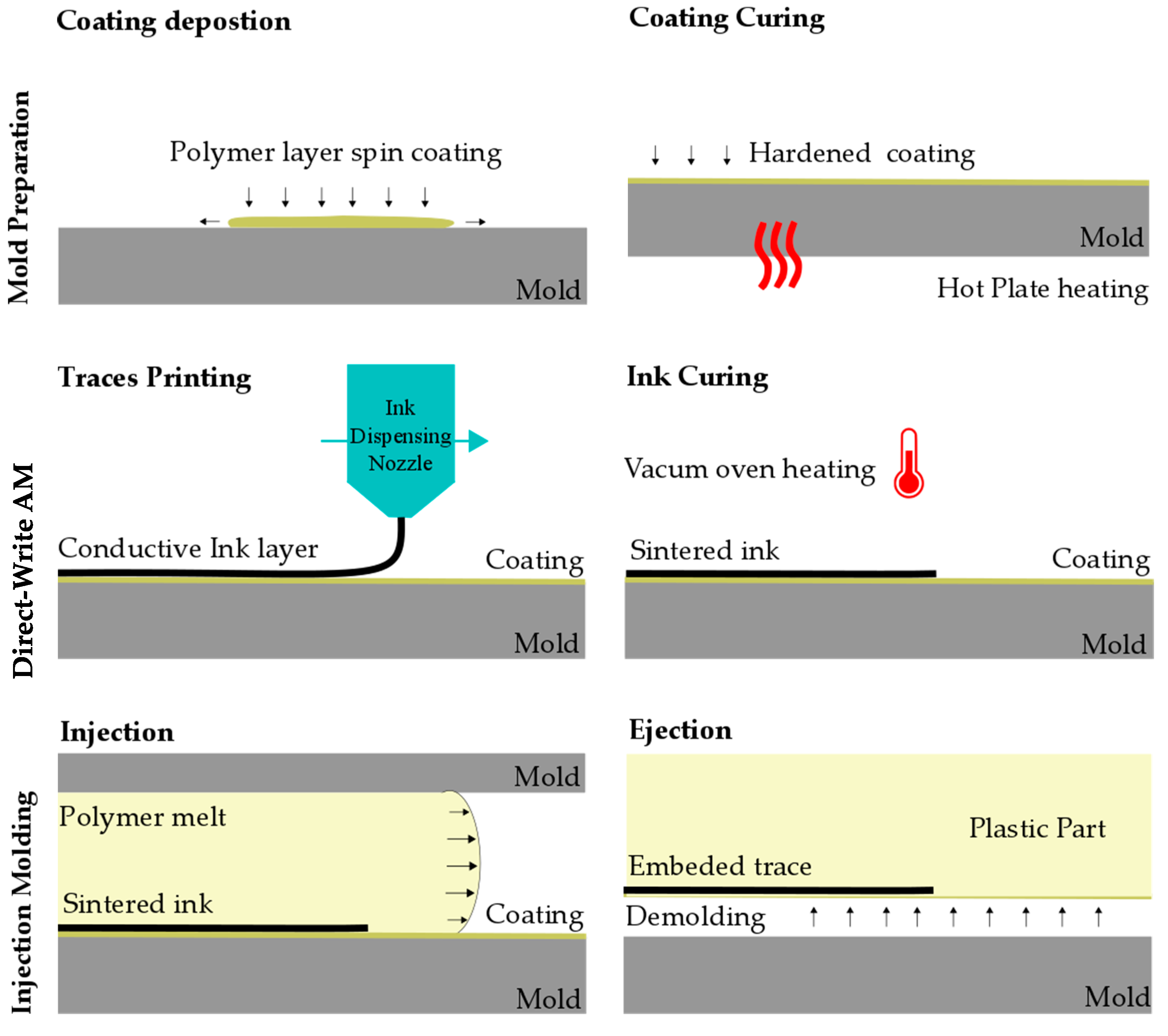
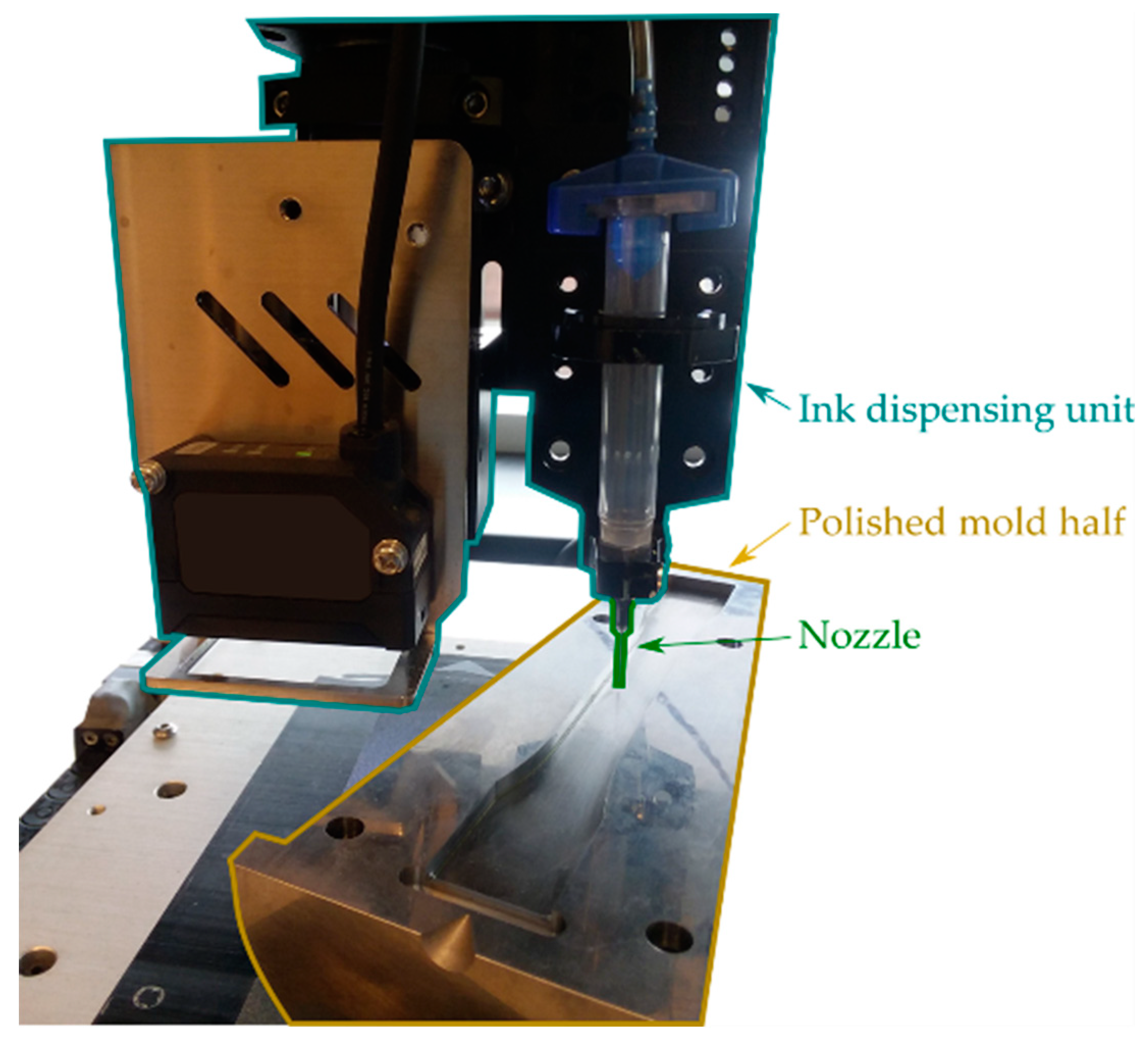

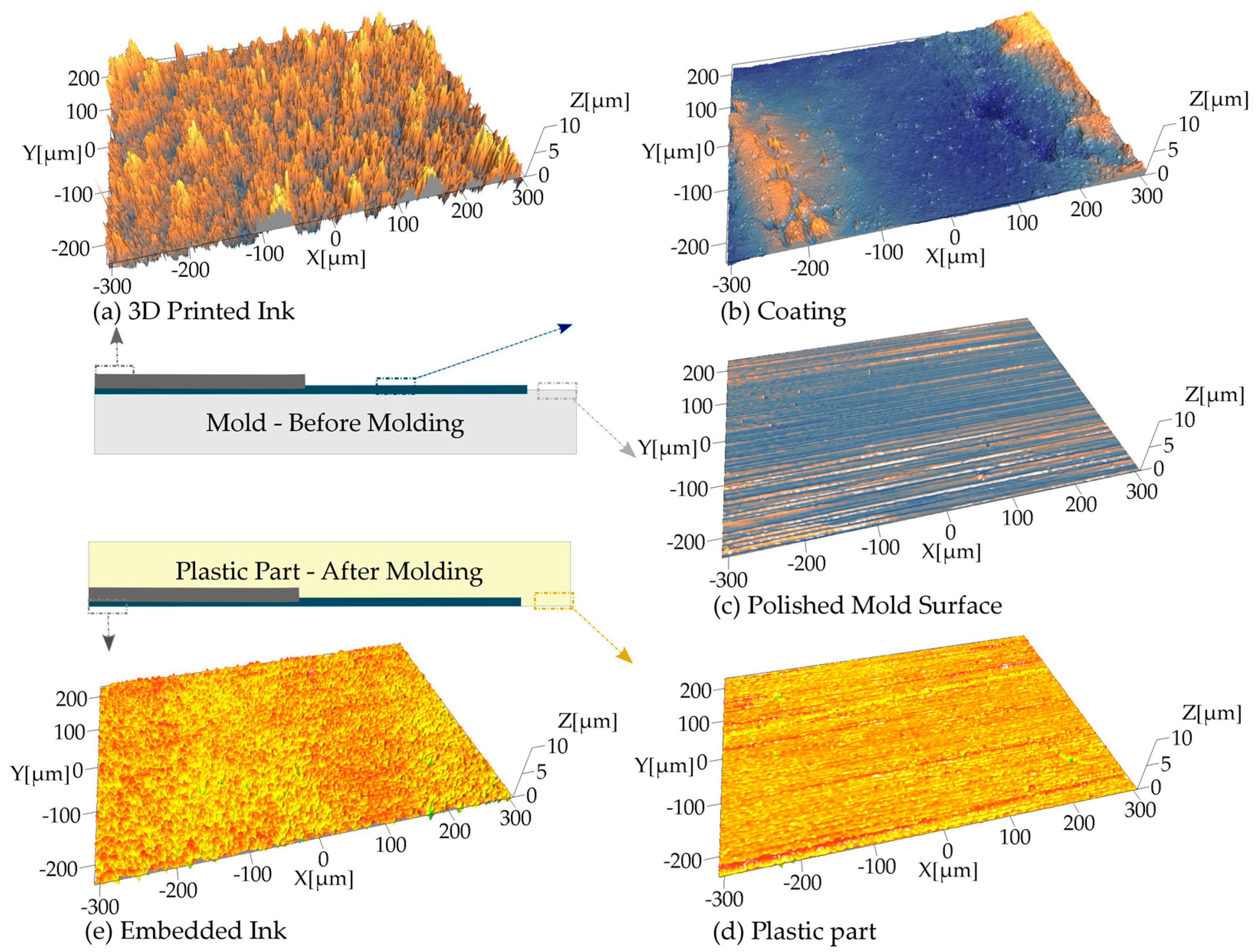


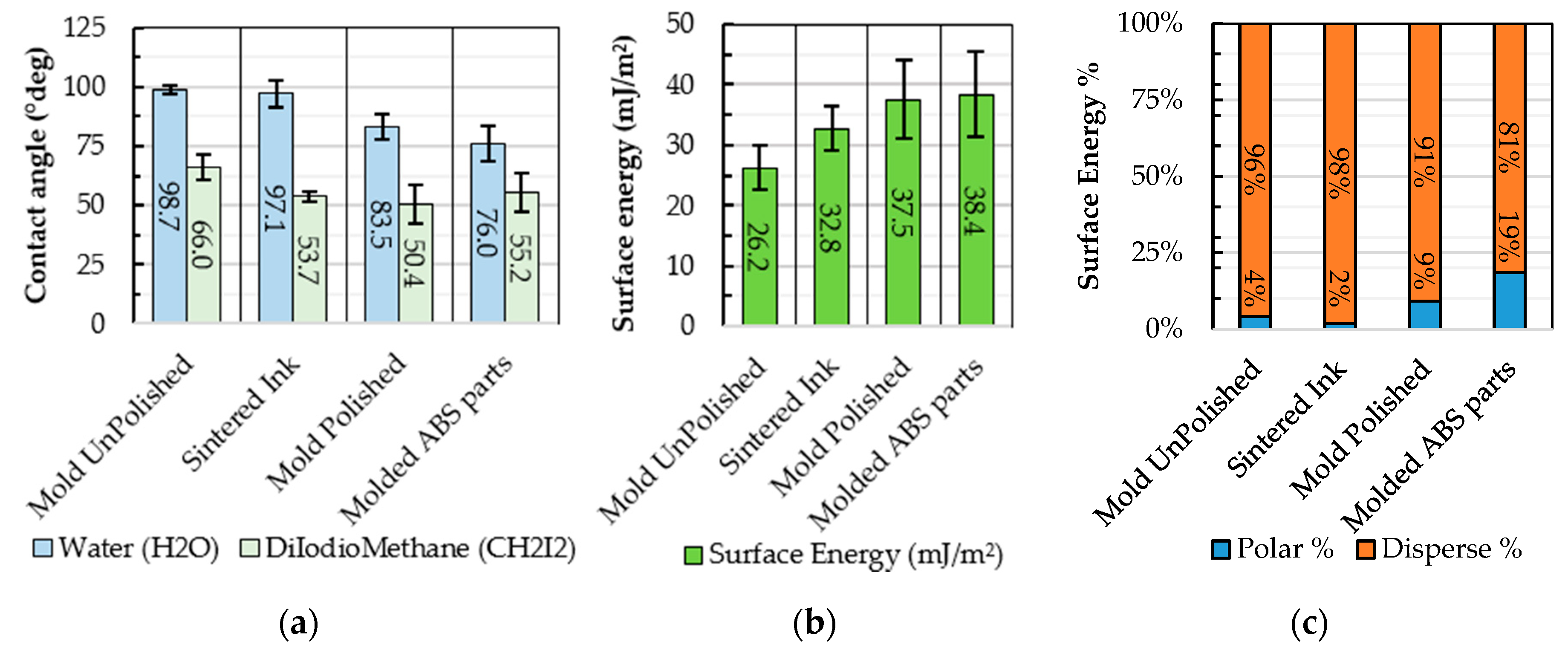


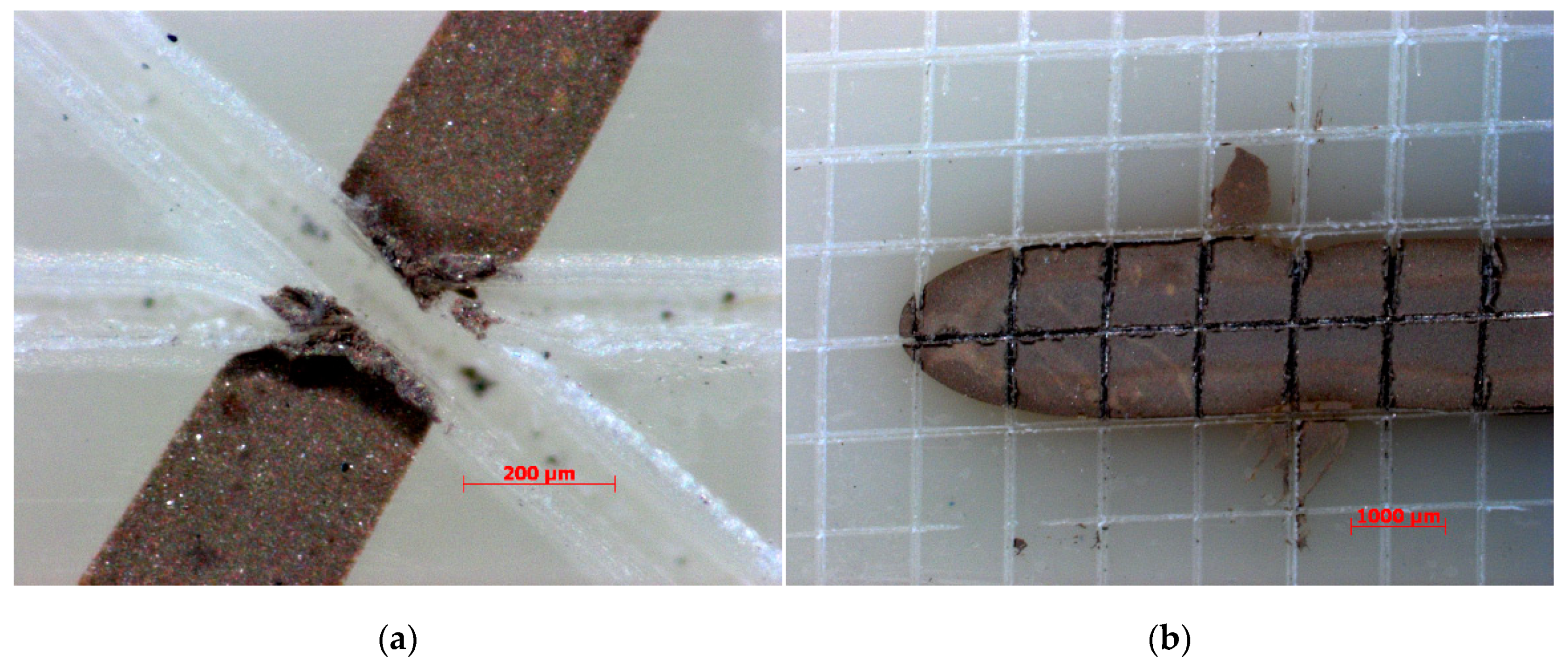
| Surface | 3D Printed Ink | Coating | Polished Mold Surface | Plastic Part | Embedded Ink |
|---|---|---|---|---|---|
| Sa/nm | 1396 | 603 | 39 | 52 | 315 |
| Ssc/µm | 1.15 | 0.10 | 0.01 | 0.02 | 0.19 |
© 2020 by the authors. Licensee MDPI, Basel, Switzerland. This article is an open access article distributed under the terms and conditions of the Creative Commons Attribution (CC BY) license (http://creativecommons.org/licenses/by/4.0/).
Share and Cite
Loaldi, D.; Piccolo, L.; Brown, E.; Tosello, G.; Shemelya, C.; Masato, D. Hybrid Process Chain for the Integration of Direct Ink Writing and Polymer Injection Molding. Micromachines 2020, 11, 509. https://doi.org/10.3390/mi11050509
Loaldi D, Piccolo L, Brown E, Tosello G, Shemelya C, Masato D. Hybrid Process Chain for the Integration of Direct Ink Writing and Polymer Injection Molding. Micromachines. 2020; 11(5):509. https://doi.org/10.3390/mi11050509
Chicago/Turabian StyleLoaldi, Dario, Leonardo Piccolo, Eric Brown, Guido Tosello, Corey Shemelya, and Davide Masato. 2020. "Hybrid Process Chain for the Integration of Direct Ink Writing and Polymer Injection Molding" Micromachines 11, no. 5: 509. https://doi.org/10.3390/mi11050509
APA StyleLoaldi, D., Piccolo, L., Brown, E., Tosello, G., Shemelya, C., & Masato, D. (2020). Hybrid Process Chain for the Integration of Direct Ink Writing and Polymer Injection Molding. Micromachines, 11(5), 509. https://doi.org/10.3390/mi11050509







